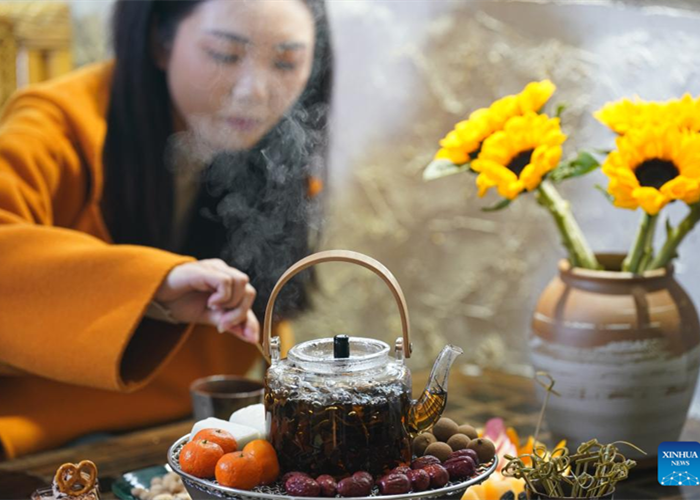Stitching Together Life Moments
Liu Lu spent 20 days of the month before her wedding making her own dress.
The 30-year-old took a course at Jiaran Studio in Beijing. And with the trainer's help, she handmade her strapless fishtail wedding dress from scratch.
"It was a tough 20-day mission, from measurements to buying materials to embroidering patterns to making the fishbone. Every step needed meticulous effort," Liu recalls.
She believes the wedding-dress course is meaningful for people who want to make their own gowns. And it can help people in costume design and production to better understand haute couture.
Embroidery artist and costume designer Shi Jiaran founded the studio in 2013. It trains students with zero knowledge of needlework to make such special garments as wedding dresses and qipao.
The novel coronavirus outbreak has pushed her in-person courses online, enabling her to reach people around the country.
The latest online course shows how to embroider camellia flowers, which requires the skill Shi learned from stitching French-style camellias.
"From the radian of each petal to the arrangement of the color of the flower's center to assembling the whole flower, each detail has to be painstakingly performed to make the flower perfect," the 33-year-old says.
Shi makes demonstration videos of how to make the flower and has live Q&A sessions. Clients also get a bag of material with necessary accessories.
Each of the studio's onsite classes has around 15 students, and the wedding-gown course is among the favorites.
It teaches about their structures and how to do the measurements. It also shows students how to transform 2D designs into 3D dresses using sewing machines.
"A customized wedding dress requires dozens of measurements," Shi says.
Jiaran Studio staffer Wang Yiran says nearly every wedding-dress class participant completes her gown, including brides-to-be.
"Some students own wedding-dress stores. They start their own customized-gown businesses after taking the course," Wang says.
"Some later start their own studios."
Overseas Chinese from Singapore and Japan also take Shi's courses.
Students must finish a wedding dress in 20 days. All have succeeded so far. The trainers help them determine the complexity and perform strict checks of every step to ensure it's completed well and on time. They operate according to a day-by-day timeline.
"It's pretty intensive," Wang says.
"Students appear on the first day with pretty makeup. Over time, they appear unkempt."
On the last day, a photographer shoots the students with their final works, including their handmade dresses.
"That's when they're pretty again," Wang says.
Shi spends half her time teaching and the other half designing, Wang says.
"Her hands are never empty," she says.
"Shi is always working on some needlework, even when she talks with us. I've never known someone so crazy about embroidery."
Shi doesn't consider herself particularly social, but Wang believes she communicates well with clients and students.
"I think she just prefers embroidering to socializing."
Shi studied costume design in Shenyang Aerospace University's School of Design and Art from 2006 to 2010, the year she became a wedding-dress designer and moved to Beijing.
She also designed accessories and dresses for Spring Festival galas before opening her own studio.
"There was a time when the inside pages of Cosmobride magazine showed photos of many brides wearing dresses I'd designed. I'm not a confident person. I never knew I'd be good at something until I discovered embroidery," She says.
One of her specialties is embroidering moon-shaped fans, which have three millennia of history in China.
"I think the moon-shaped fan is like a carrier of Chinese culture. And it's a daily-use item. I combine embroidery skills from Suzhou, France and India, and present Chinese culture on the fan," Shi says.
For example, the red-crowned crane that Shi embroiders is three-dimensional. Its feathers are attached to the fan, and its wing can open as if on a hinge. This is a modern innovation that doesn't belong to any traditional style, she says.
"As long as it's beautiful, there should be no boundaries," she says.
Her workstation can simply be a fan, a needle and a box of sequins.
Each fan takes her around 10 days, from paper sketches to finding materials and matching colors.
"The key is to repeatedly revise the design," she says.
Shi's designs mostly focus on four series, including the Palace Museum and landscapes. Zaojing (caisson ceilings) are one of her favorite motifs.
Shi uses special bamboo and cloth. She has finished more than 100 embroidered fans, which are exhibited twice a year in different cities in China.
Shi also studies many other seemingly unrelated subjects that actually improve her embroidery, she says. She took half a year to learn cosmetology and is now practicing photography. Her travel photos sometimes inspire her fan designs.
She also makes round silk-fan brooches.
Shi recently spent three months on her newest creation, embroidered earphone cases. She took inspiration from traditional Chinese perfumed sachets.
"I wouldn't be able to make the earphone cases if I hadn't learned about making pouches," she says.
Shi believes there are many more possibilities of incorporating embroidery into daily products, such as the glasses cases and lipstick pouches.
"I hope more people can become interested in embroidery," she says.
"Immersing yourself in needlework can help you forget about a bad mood."
(Source: China Daily)
Please understand that womenofchina.cn,a non-profit, information-communication website, cannot reach every writer before using articles and images. For copyright issues, please contact us by emailing: website@womenofchina.cn. The articles published and opinions expressed on this website represent the opinions of writers and are not necessarily shared by womenofchina.cn.








 WeChat
WeChat Weibo
Weibo 京公网安备 11010102004314号
京公网安备 11010102004314号